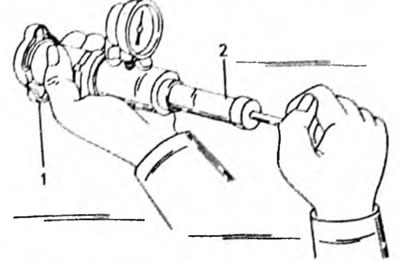4.2.1. Removing the radiator
- Drain the coolant according to the instructions in chapter 4.1.
- Disconnect the upper and lower water hoses after releasing their clamps.
- Disconnect the battery terminals.
- Disconnect the wire connection of the fan motor cable harness, and also disconnect the wire from the temperature switch to turn on the fan.
- If equipped with an automatic transmission, disconnect both oil cooler hoses. At the same time, drain the liquid, collecting it appropriately.
- If the air filter hose is in the way, disconnect it.
- Disconnect the bypass hose between the expansion tank and the radiator.
- Unscrew the fan casing and move it to the side.
- On each side, unscrew the radiator mounting bracket and pull out the radiator without touching the body parts of the Pi engine. Check for cracks in the cooling system hoses and replace them if damaged. Check for leaks on the radiator, which are often identified by corrosion. Take a leaking radiator to a workshop for repair. If you have a radiator test pump, you can perform a pressure test on the radiator cap. To do this, install the pump on the cover, as shown in Figure 121, and put it under pressure. The valve in the lid should open at a pressure of 0.8-1.0 atm. The permissible minimum pressure is 0.6 atm. Using the same method, you can also put the radiator itself under pressure after installing it. To do this, connect the pump as shown in Figure 122 and raise the pressure with the pump to 1.2 atm. The pressure reading should not decrease during the test. Only the radiator block itself is supplied as a spare part. Since a special tool is required to remove and secure the upper and lower water coolers, you should contact a TOYOTA workshop to assemble the radiator kit.

Pic. 121. Checking the radiator cap using a radiator test pump

Pic. 122. To check radiator leaks, connect a test pump (1) using a hose (2) to the radiator filler neck.
4.2.2. Removal
Removal is carried out in reverse order. If defects are suspected, be sure to replace the hoses. Fill the cooling system as described in section 4.1. After warming up the engine to operating temperature, check for leaks. If there is a pressure test pump, test the system under pressure (no more than 1.2 atm). If the pressure drops, there is a leak. In this case, park the car in a dry place to determine where the fluid is leaking.
